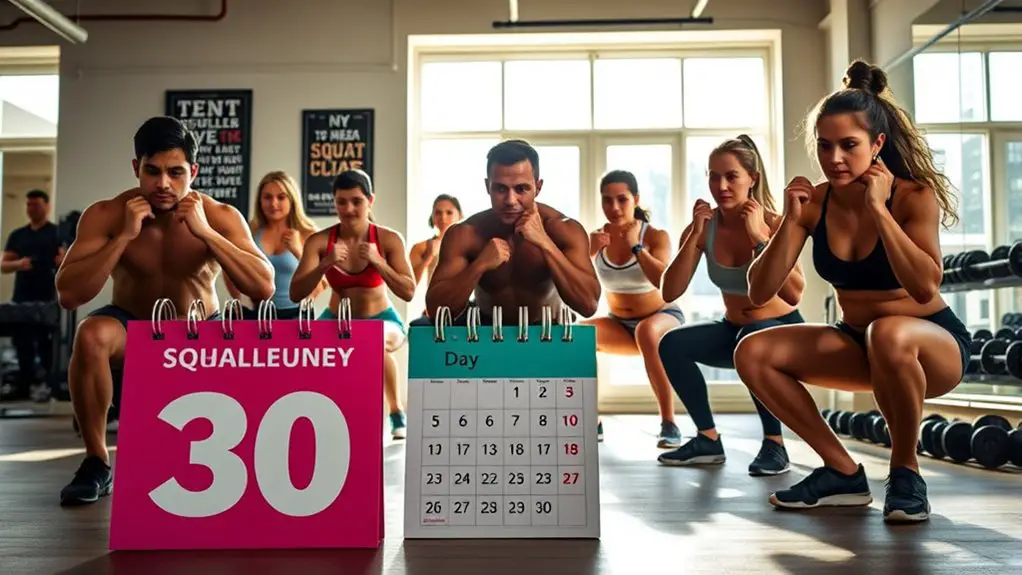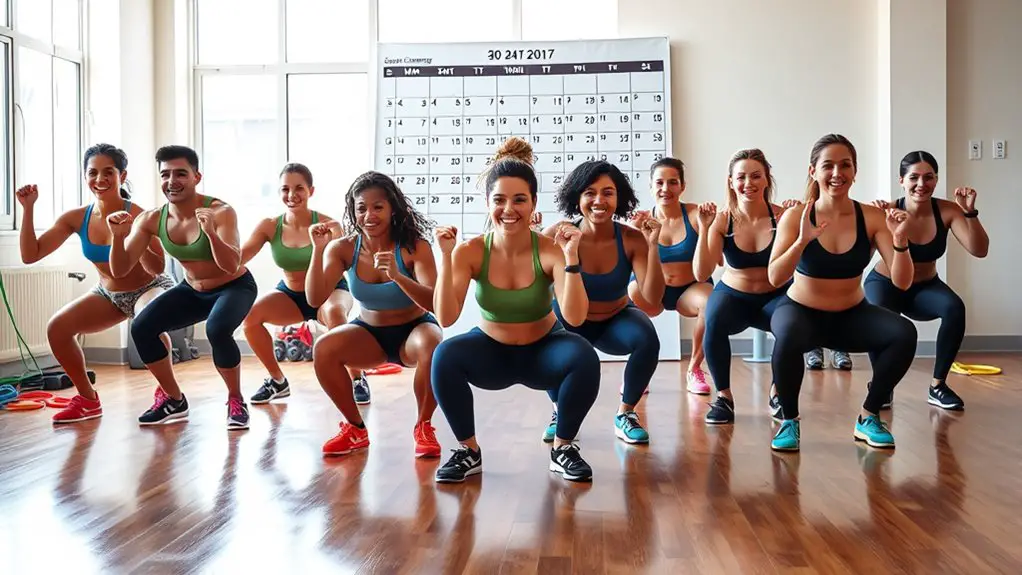The 30-Day Squat Challenge: Does It Work?

The 30-Day Squat Challenge can definitely work for building lower body strength and toning your glutes and legs. As you gradually increase your repetitions, you’ll engage multiple muscle groups, boosting your metabolism. However, it’s important to maintain proper form and consider joint health. While many report positive transformations, it’s vital to mix in other exercises to prevent muscle imbalances. Discover more about the challenge’s structure and expert opinions on its effectiveness to maximize your results.
Understanding the 30-Day Squat Challenge

The 30-Day Squat Challenge is a straightforward yet effective way to build strength and tone your lower body. As you start this challenge, it’s essential to prioritize safety by focusing on proper form. You’ll begin with basic squats, gradually introducing squat variations like sumo squats and jump squats to keep your workout engaging and effective. This variation not only targets different muscle groups but also helps prevent boredom, boosting your challenge motivation. Additionally, if you experience any discomfort, consider incorporating alternatives like the goblet squat to reduce strain on your knees while still achieving your fitness goals. Listen to your body and adjust the intensity if you feel any discomfort. It’s perfectly okay to take breaks or modify your squat depth to maintain safety. Staying consistent throughout the 30 days will help you see real progress, so keep a positive mindset. Remember, the goal isn’t just to complete the challenge but to do so safely and effectively, building a solid foundation for your fitness journey.
The Science of Squats
When you think about squats, it’s important to contemplate how they engage different muscle groups and their impact on your joints. Understanding these dynamics can help you maximize your workout while minimizing injury risk. Plus, knowing how squats affect caloric burn can motivate you to push through the challenge.
Muscle Engagement Dynamics
Though squats might seem like a straightforward exercise, the muscle engagement dynamics at play are quite intricate. Understanding muscle activation and squat mechanics can help you perform them safely and effectively. Here’s a quick breakdown of the primary muscles involved:
| Muscle Group | Role in Squats |
|---|---|
| Quadriceps | Extends the knee |
| Hamstrings | Flexes the knee |
| Glutes | Hip extension |
| Core Muscles | Stabilizes the torso |
| Calves | Supports ankle stability |
Joint Health Considerations
While squats can be a fantastic addition to your workout routine, it’s important to contemplate their impact on joint health. You need to make sure that your joints, particularly your knees and hips, are capable of handling the stress of repeated squatting. Proper form is vital for maintaining joint mobility and preventing injuries. If you feel any discomfort or pain, it’s a sign to reassess your technique or adjust your range of motion. Incorporating dynamic stretches before your workout can enhance your joint mobility, making your squats safer and more effective. Remember, injury prevention is key; don’t rush into higher repetitions without building a solid foundation. Listen to your body, and always prioritize safety over intensity.
Caloric Burn Impact
Understanding joint health is important, but it’s also key to recognize how squats can impact your caloric burn. When you perform squats, you engage multiple muscle groups, which can lead to a metabolism boost. This increase in metabolic rate can help create a caloric deficit, especially when combined with a balanced diet.
However, to maximize this effect safely, focus on proper form and gradual progression. Avoid pushing yourself too hard too quickly, as this can lead to injury. Instead, listen to your body and allow for recovery. Incorporating squats into your routine can be beneficial for both strength and calorie burning, but always prioritize safety to guarantee long-term results.
Benefits of Squats for Glute and Leg Strength
When you incorporate squats into your workout routine, you’ll quickly notice the numerous benefits they provide for glute and leg strength. Squats are excellent for glute activation, helping to build and tone your muscles effectively. By engaging your glutes regularly, you’ll see improvements in both strength and shape, which can enhance your overall physique.
Moreover, squats play an essential role in increasing leg endurance. As you increase the number of repetitions, your legs become more resilient, enabling you to perform daily activities with ease. With proper form, you can guarantee safety and reduce the risk of injury, making squats a fantastic addition to your fitness regimen.
Incorporating variations like sumo or jump squats can further enhance these benefits. So, whether you’re a beginner or more advanced, squats can help you achieve stronger legs and glutes while keeping your workouts safe and effective.
Potential Risks and Considerations

Although squats are a great addition to your fitness routine, it’s important to be aware of potential risks and considerations. Performing squats incorrectly can lead to squat injuries, especially if you experience form breakdown as you progress. It’s vital to maintain proper technique to minimize joint strain and prevent muscle fatigue.
If you’re pushing yourself too hard, you might face overtraining risks, which can hinder your recovery time and overall progress. Incorporating workout variety is essential to avoid repetitive stress on your joints and muscles. Remember, your fitness journey should align with your personalized goals rather than just following a challenge.
Listen to your body and adjust your routine as needed. If you feel excessive fatigue or discomfort, consider taking a break or consulting a fitness professional. By prioritizing safety, you can enjoy the benefits of squats while minimizing potential risks.
How the Challenge Works: A Breakdown
In the 30-Day Squat Challenge, you’ll follow a structured daily repetition plan that gradually increases in intensity. Each day is designed to help you build strength and endurance over time. By the end of the month, you’ll see significant progress in your squat performance.
Daily Repetition Structure
As you commence the 30-Day Squat Challenge, you’ll find that the daily repetition structure is designed to gradually increase your strength and endurance. Each day, you’ll perform a set number of squats, following a carefully planned daily progression. This approach guarantees you’re not overwhelmed, allowing your muscles to adapt safely to the increasing demands. For instance, you might start with just a few reps, and as the days progress, you’ll notice a repetition increase that helps build your confidence and capability. It’s imperative to listen to your body; if you feel discomfort, consider adjusting the repetitions or taking a rest day. Remember, consistency is key, but safety should always be your top priority throughout this challenge.
Progression Over Time
To maximize your results during the 30-Day Squat Challenge, understanding how the progression works is essential. Each week, you’ll notice a gradual increase in the number of squats, designed to challenge your muscles without overwhelming them. This gradual approach helps prevent injury and promotes safe improvement.
It’s vital to engage in progress tracking throughout the challenge. Keeping a log of your daily repetitions not only motivates you but allows you to see how far you’ve come. If you ever feel discomfort, don’t hesitate to adjust the number of squats or take a rest day. Remember, your body needs time to adapt, and listening to it is key for long-term success in building strength and endurance.
Success Stories: Transformations From the Challenge

While many participants start the 30-Day Squat Challenge with hopes of toning their bodies, the real transformations often extend beyond physical appearances. You’ll find that success stories and personal testimonials reveal deeper impacts on mental and emotional well-being.
- Increased confidence in your own body
- Enhanced motivation to pursue fitness goals
- Development of a consistent workout routine
- Stronger sense of community among participants
- Improved overall mood and stress relief
These transformations can be profound, as the challenge fosters not just physical strength but also resilience. Participants often report feeling empowered, showcasing how a simple commitment to daily squats can lead to a more positive mindset. You may discover that every squat helps build not just muscle, but also a stronger you. As you commence on this journey, remember that each step forward counts, and your success story is waiting to unfold.
Expert Opinions on the Challenge’s Effectiveness
Many individuals who complete the 30-Day Squat Challenge find that the physical benefits are just the tip of the iceberg. Expert insights suggest that while this challenge can enhance muscle endurance and strength, it might not address overall fitness thoroughly. Effectiveness analysis reveals that focusing solely on squats can lead to muscle imbalances if you’re not incorporating other exercises.
Experts often emphasize the importance of a balanced workout routine that includes upper body and core exercises, as well as flexibility training. They also caution against overexertion, especially if you’re new to exercise. It’s vital to listen to your body and modify the challenge as needed to prevent injury. While the challenge may provide a motivational boost, ensuring a safe and well-rounded fitness plan is significant for long-term success. Remember, it’s about building a sustainable routine rather than just completing a month-long challenge.
Alternatives to the 30-Day Squat Challenge
If you’re looking for effective alternatives to the 30-Day Squat Challenge, there are plenty of options that can keep your workout routine fresh and balanced. Incorporating a variety of bodyweight exercises can enhance your strength training while minimizing injury risk. Here are some alternatives to take into account:
- Lunges: Great for targeting different muscle groups in your legs.
- Step-ups: Use a sturdy platform to build strength and stability.
- Glute bridges: Strengthen your glutes and core without straining your knees.
- Plank variations: Engage your entire body while focusing on core strength.
- Resistance band exercises: These can add variety and resistance while being gentle on joints.
Additionally, consider exercises like the Half-Kneeling Cable Press to engage your core while providing a different challenge for your upper body. These alternatives not only keep your workouts interesting but also guarantee you’re developing strength safely and effectively. By mixing them into your routine, you’ll promote overall fitness and reduce the monotony of a single exercise challenge.
Frequently Asked Questions
Can Beginners Safely Start the 30-DAY Squat Challenge?
They say, “Slow and steady wins the race,” and that’s especially true for beginners. You can safely start a squat challenge, but it’s essential to listen to your body. Consider squat modifications like wall sits or chair squats to ease into the exercise. Remember to focus on form over quantity. Beginner tips include warming up beforehand and gradually increasing your reps. Always prioritize safety to prevent injury as you build strength.
What Equipment Is Needed for the Squat Challenge?
For the squat challenge, you don’t need much equipment. A mat can provide comfort during floor exercises, while resistance bands or dumbbells can enhance squat variations to help meet your fitness goals. If you’re aiming for safety, make certain your space is clear, and consider using a mirror to check your form. Always listen to your body, and adjust the intensity as needed to avoid injury while progressing towards your goals.
Is It Safe to Do Squats Every Day?
Imagine squatting like a pogo stick on a caffeine high—fun until you bounce into an injury! Doing squats every day isn’t inherently unsafe, but your body deserves variety. Incorporating squat variations can keep things fresh and reduce strain. Listen to your body; if something feels off, it’s time to slow down and focus on injury prevention. Remember, a healthy routine is about balance, not just the thrill of daily squats!
How Can I Track My Progress During the Challenge?
To track your progress during any fitness challenge, consider keeping a progress journal. You can jot down daily reps, sets, and how you feel after each workout. Alternatively, using a fitness app can help you log your workouts, set reminders, and visualize your improvements. Just remember to listen to your body and adjust your routine if you feel any discomfort. This way, you’ll stay safe while effectively monitoring your progress!
Are There Any Dietary Recommendations While Doing the Challenge?
When you’re starting on a journey of transformation, like Hercules facing his labors, it’s vital to fuel your body wisely. Focus on nutritional tips that emphasize whole foods—fruits, vegetables, lean proteins, and healthy fats. Consider meal plans that keep your energy levels up while aiding recovery. Staying hydrated is important too. By nourishing yourself appropriately, you’ll not only support your workouts but also guarantee your body stays safe and strong throughout the challenge.





